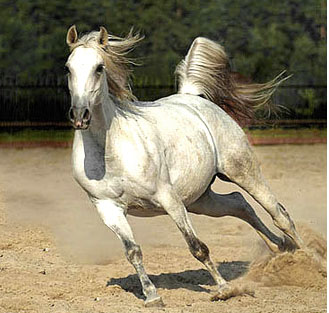 There’s one in every bunch. It’s the horse that keeps his eye on you and no matter what enticement you offer from your pocket, he won’t let you catch him. Trail rides and planned events get put on hold while you’re out chasing the ornery scoundrel around the paddock, getting more frustrated by the minute and vowing to never let him out of his stall again. One hard-to-catch horse can even make gentle horses in the pasture more spooky, causing more trouble all around. Is there a cure for the horse that is hard to catch? Well, here are a few tried and tested tips that might eliminate some wasted time and frustration when you’re trying to catch your horse.
There’s one in every bunch. It’s the horse that keeps his eye on you and no matter what enticement you offer from your pocket, he won’t let you catch him. Trail rides and planned events get put on hold while you’re out chasing the ornery scoundrel around the paddock, getting more frustrated by the minute and vowing to never let him out of his stall again. One hard-to-catch horse can even make gentle horses in the pasture more spooky, causing more trouble all around. Is there a cure for the horse that is hard to catch? Well, here are a few tried and tested tips that might eliminate some wasted time and frustration when you’re trying to catch your horse.
1. Always have a plan.
For instance, if your horse is normally stalled and has daily turnout, plan to ride him before he is turned out to pasture. That way, he’s already enclosed in a small area and you won’t be chasing him around the five acre field in your riding boots. If you have a trail ride planned for the next day, keep him overnight in a smaller pen so it’s a quicker catch in the morning.
2. Carry treats with you.
Establish this as a part of your riding attire. When you put on your boots, fill your pockets with treats. Don’t be caught with empty pockets. That being said, don’t allow horses to be pushy with your pockets—nibbling, nipping, or biting at the other horses in greed are unnacceptable behaviors. When you walk through the paddock your horse is in, offer treats to any other horses that are kept with him. He will be more interested in you if he knows you carry treats.
3. Catch your horse many times but ride him only a few.
If your horse knows that every time you catch him, he has to be saddled, ridden, and worked hard, he will likely develop a sour attitude at being caught. This can be alleviated by catching him at odd times to groom him instead of ride, or to move him to a different paddock with more grass, or just to bring him in and give him some grain. If a horse is caught more often for feeding or pampering than riding or working, he will associate being caught with good things.
4. Be sly with your approach.
A horse can tell the difference between when you are coming out with grain from when you are coming out with a halter to catch him. Hold the halter close to your body and don’t let the buckle jingle loudly. Have the end of the rope ready to slip around his neck with your arm, as if you’re only petting him. If you have a broke horse with “eagle eyes” who spots your halter at 100 yards and bolts, you can even use a short (4 foot) length of rope or baling twine in your pocket and pull it out to slip around his neck as you’re feeding him a treat. When you approach a horse, use calm body language and walk at a side angle to the horse, not directly at his face or coming up behind him. When you touch a horse, touch him near the shoulder or withers, as this is a more friendly space where horses affectionately rub each other. From there, you can slide an arm under his neck and get the halter rope around him so he can’t duck away and run. As soon as you get the halter on, give him a treat. Do this every time you catch him.
5. Never chase a horse.
Unless you can top speeds of 35 miles an hour, don’t chase or run after a horse that is evading you. It will only shorten your patience, heighten your frustration, and make the horse run faster. Horses are flight animals, which means their best defense and strongest instinct is to run. To win them over, you have to appeal to their other instincts such as the desire to eat or the desire to avoid work. And that leads us to two other options to try that might help you catch your horse.
6. Teach the horse to come to you to be caught using the join up approach.
A good trainer can work a horse in a round pen and train it to always turn to the handler and stay near to avoid having to work. If done correctly, this usually results in a horse that prefers coming to you and spending time close to you as opposed to running away from you. You can read my article on join up and see if this option might benefit your horse. This option works best if the horse is genuinely afraid of you, and is wary of being caught because it is not comfortable being handled yet.
7. Have other riders or people on foot help you catch your horse.
For a horse that is not afraid, and is simply being ornery and not allowing you to catch him, get a bunch of experienced riders to help you out. Arm yourself with a grain bucket and halter and go stand in the middle of the paddock or in the pasture near your horse. Do not attempt to catch him, simply stand there quietly and maybe shake the bucket once or twice. The other riders should watch the horse closely and not let him rest unless he is close to you. For instance, they should position themselves in the four corners of the pen, or around the pasture, and always move the horse in a trot if the horse is aimed away from you. When the horse turns towards you, they should slow down and leave the horse alone as long as he is moving towards you. If he stops to graze or moves away from you again, the riders should quickly make him work at a trot, so that anytime the horse is not looking and focusing and moving towards you, he gets chased or worked. This might take awhile, but in time the horse should come to you because you are the only rest and comfort he can find, and he will seek that out. A broke horse that is just being ornery will likely let himself be caught within a few minutes of this, and learn to always be caught so that this type of treatment is never necessary.
Hopefully these ideas will be a great help to some of my readers. I have definitely been there, chasing a horse through pouring rain in cowboy boots that were filling with water, and the time you put into training a horse to be caught happily will really be worth it in the long run. Good luck!
Special thanks to my friend Karen for some great tips and suggestions on this article. If you have any great horse-catching solutions of your own, please comment and share them!


{ 1 comment }
I once boarded my appy gelding at a farm that had 40 acres as 1 big pasture. It covered the side and top off large hill. With the trees and hill climb you often couldn’t see your horse to go out and get him – you had to walk up the hill for quite awhile, through the woods (following a well-worn-by-little-hooves trail) to get to the meadow on top where the herd usually hung out. When I would get up there, my horse would inevitably be on the far side of the 15 acre pasture! Whistling and calling did not good – he would look at me, and put his head back down to eat. I soon learned that if I called him, and he looked up & saw me, I would mentally count to 3 – if those hooves didn’t head in my direction by 3, I started emptying the treats in my pockets VERY obviously to the nearest horses. THEN if he STILL didn’t come – I would walk over and catch him, and if my pockets were empty – oh well – too bad! Anyway, after a few days of doing this, he started coming to me as soon I whistled from the edge of the meadow. Within a month he would come DOWN the trail from the meadow to meet me on the trail when I whistled, and finally – if the wind was right – he got to where I could whistle & call him from the gate @ the bottom and he would come running (lots of fun to see – always made me smile!). Now, 20 years later he still comes from wherever he is to meet me when I whistle 😀 It has come in handy over the years too, because sometimes we’ve parted ways on the trail and he will stop from a dead gallop and come back to that whistle. Pavlov knew his stuff! LOL